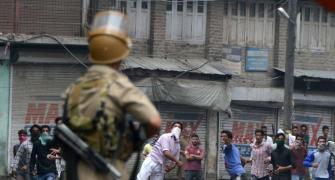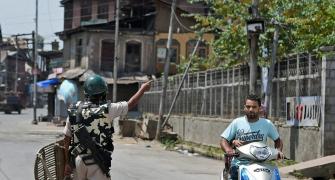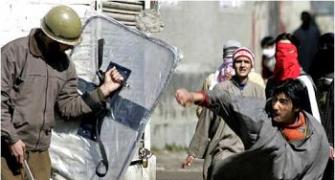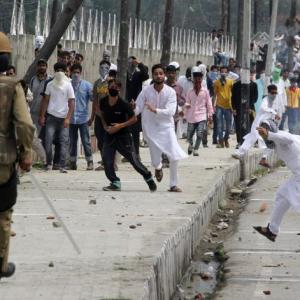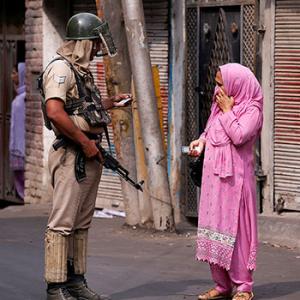In parts of South Kashmir, especially in Pulwama district, the government's writ has effectively ceased to run.
The daily confrontation that follows the lifting of the curfew bears an indescribable fury.
For a Valley on the boil, there is ample proof that New Delhi simply does not care. Ajai Shukla reports from Ground Zero of the Kashmir protests.

Three weeks after idolised Hizbul Mujahideen militant Burhan Wani was killed by the Jammu and Kashmir Police in an encounter near Anantnag in southern Kashmir, the Valley continues to seethe.
In Srinagar, extended curfews have failed to end furious stone-pelting by violent mobs.
This correspondent visit the city's so-called downtown area at 6 pm, after hearing that curfew would be briefly lifted at 6.30 pm.
This locality has long been the stronghold of the Mirwaiz of Kashmir, currently the soft-spoken Omar Farooq, whose Awami Action Committee anchors the separatist Hurriyat Conference.
But the Mirwaiz, like other Hurriyat leaders, counts for little now.
Separatist leadership is now in the hands of fresh-faced Kashmiri youths, some as young as 16, who are following their impulses without coordination or thought.
Bearing the brunt of their blind anger against any manifestation of the Indian state is a mixed posse of J&K Police and the Central Reserve Police Force personnel, who have spent the day on "curfew enforcement"; strung out across the locality in exposed groups of three-four troopers.
At 6.15 pm, I join them as they reel in towards a central collection point. On their heels follow the "stone pelters" -- official terminology in the J&K security establishment.
The daily confrontation that follows bears an indescribable fury.
Running out from homes and alleyways, the youngsters use slingshots and their bare arms to hurl large stones that ricochet off protected vehicles and bounce dangerously off the street.
The police are under strict instructions to moderate their response; no agitator should be killed or badly injured -- an eventuality that could trigger stepped up violence.
Under pressure from the advancing mob, the troopers fire teargas to push back the darting youths.
The 12-gauge shotguns are loaded, but held in reserve in case the troopers are getting swamped. After what seems like a lifetime, the police withdraw into heavily-guarded police stations, ceding the space outside to the mob.
This frightening contest takes place each time curfew is lifted.
I ask Inspector Javed Bhat (name changed to protect identity), who has just overseen this withdrawal, how everyone handles the danger.
"We let them vent their anger. As long as no agitator is injured, we consider it a job well done."
This sums up the strategy for calming down the Valley after 55 Kashmiri deaths and some 2,000 injuries, including 300 that required hospitalisation.
Many of these took place when rampaging mobs were about to overrun police stations and outposts.
With panic-stricken troopers firing shotguns at point-blank ranges, the 450 pellets in each cartridge blinded many agitators, stoking anger further.

Yet, Srinagar represents the good news for the administration.
In parts of South Kashmir, especially in Pulwama district, the government's writ has effectively ceased to run.
The locals have begun calling Pulwama a "liberated zone".
Shuja'at Bukhari, editor of the Valley's second-biggest English daily, Rising Kashmir, described a procession of 30,000 locals on Sunday, screaming for Azaadi (freedom) at the local "martyr's graveyard".
That protest featured several armed militants, including Abu Dujana, the local Lashkar-e-Tayiba commander who hails from Pakistan.
On Monday, it was the turn of Shopian, where 10,000 people came out in protest.
South Kashmir was the stamping ground of Burhan Wani, who was less a conventional gun-wielding militant than a social media celebrity, with his videos urging Kashmiris to join the Hizbul Mujahideen.
Says a senior police officer: "Without firing a shot, Burhan became more dangerous than other militants."
So furious was the reaction to his killing that mobs in South Kashmir burnt three police stations to the ground. Police posts were torched.
The J&K Police's special operations group, the unit that actually shot down Burhan Wani, paid an especially heavy price: Four SOG camps were set ablaze.
Asked whether there is a strategy to regain control, Suhail Bukhari, the J&K government's media consultant, said: "We are avoiding a vicious cycle of violence where each death leads to another, and further inflames the situation."
While Chief Minister Mehbooba Mufti has launched an outreach programme to visit the families of locals killed, there is an eerie silence from New Delhi. Home Minister Rajnath Singh visited Kashmir a week ago, but the prime minister has remained silent.
For a Valley on the boil, this is further proof that New Delhi simply does not care.
There was little love for the United Progressive Alliance government, under which the Valley experienced three successive summers of turmoil: In 2008, over the proposal to acquire land for the Amarnath Yatra; in 2009, over the deaths of two women in Shopian; and in 2010 over the killings of civilians in Machhil in a fake encounter.
Now, there is even greater resentment at the National Democratic Alliance government, with Kashmiris deeply resenting issues like beef ban, the Dadri lynching, and a series of local controversies that are perceived as an assault on the Kashmiri identity -- not least the apprehension that New Delhi intends to change the Valley's demographic profile by establishing "Pandit colonies" and "Sainik colonies".


